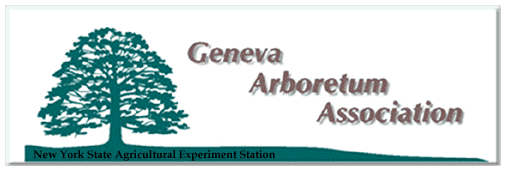

Located
on the south lawn of the IPM building, the Experiment Station's Crataegus
phaenopyrum, or Washington Thorns, provide bright cheery notes in
what can sometimes be a dark and dreary fall landscape. One tree is located
on the right corner of the IPM parking area and is particularly nice with
the bronze foliage of the massive Swamp White Oak (Quercus bicolor)
behind it for contrast. The second tree provides a showy contrast to its
nearby orange-fruited rose family neighbor, a flowering crab (Malus
adstringens), on the IPM lawn near the corner of Castle Street and Collier
Drive. The berries on these trees persist well into winter and are even
more vivid with a little new snow as a backdrop. They make a lovely picture
from the Collier Drive windows of Barton Lab.
The Crataegus phaenopyrum, or Washington Thorn, is a member of the Rose family, along with many other Station trees and shrubs like Apple, Crabapple, Hawthorn, Flowering Quince, Cotoneaster, June berry (Amelanchier), Spirea, Kursan Cherry, and Mountain Ash.
The Rose family, known to botanists as Rosaceae, is a family in the order Rosales, which is the second largest order among flowering plants. It includes about 18,000 species, 13,000 of which are in the pea family. Plant orders and families have been developed based on a study of the flower structure of plants, which are then grouped according to their similarities. Rosaceae is a large family with more than 100 genera and between 2,000 to 3,000 species. Subfamilies, or groups of Rosaceae, include Spirea, Rose, Plum, and Apple. Other roses you may know "by any other name" could include Strawberry, Blackberry, Raspberry, Loganberry, Potentilla, Prune, Plum, Apricot, Almond, Peach, Nectarine, and, of course, the cultivated and wild Rose, to name a few.
Members of the Rose family or Rosaceae are distributed nearly everywhere, with most of the species being centered in north temperate regions.
Our current rose "by any other name", C. phaenopyrum, is native to the Southeastern United States and is found either as a small tree with a slender trunk or sometimes a large shrub. It has been widely planted for its clusters of white flowers (May and June), bright red berries (often referred to as `haws') and bright orange to scarlet autumn leaves.
So, if you're interested in spicing up your fall and winter garden, these rose family members should be a definite addition to your landscape.
by Cathy Heidenreich
Locations of these and other roses on campus can be found in "A Guide to Woody Ornamentals of the New York State Agricultural Experiment Station" which is available from the Bulletin Room for $3.00.
Next ( Beech)
Return to Arboretum Home Page
Return to NYS Agricultural Experiment Station Home Page
Page maintained by Thomas Björkman
Last modified January 21,1998
http://www.nysaes.cornell.edu/arboretum/l_tulipifera.html